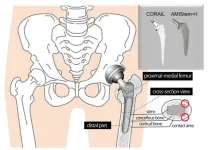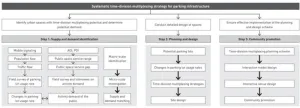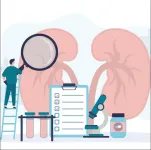(Press-News.org) A new method that can rapidly determine whether a virus is infectious or non-infectious could revolutionise the response to future pandemics.
Called FAIRY (Fluorescence Assay for vIRal IntegritY), the assay can screen viruses against virucidal antivirals in minutes, allowing for the effectiveness of antiviral measures, such as disinfectants that break the chain of infection, to be quickly determined.
Dr Samuel Jones from Birmingham’s School of Chemistry led the research team that developed the FAIRY assay. He said: “On average, every four years a new virus is discovered that has pandemic potential, and there are many more already known viruses that could cross the species barrier. Yet to best of our knowledge there is currently no assay capable of identifying whether a sample contains intact or non-intact viruses, and therefore shows whether it is infectious or non-infectious, without cell cultivation that could take weeks.”
The current gold standard method for determining viral infectivity uses cultured cells, which takes many days to show results, requires specialist staff to do the testing, and also needs a cultivatable cell line, which is not available for all viruses. The need to use cultured cells also limits current techniques to antivirals that are non-damaging to cells, making the discovery of new disinfectant solutions an additional challenge.
The new method uses a dye that can ordinarily penetrate viruses through pores in the capsid (protein shell) that surrounds its genetic material (DNA or RNA). This dye is conjugated to a larger molecule, which prevents it from penetrating the capsid pores. When the dye binds to viral DNA or RNA it provides a fluorescent signal.
The resulting assay shows whether the virus is intact, and therefore infectious, or not.
The researchers have evaluated the effectiveness of the assay using herpes simplex virus (HSV-2), respiratory syncytial virus (RSV), cytomegalovirus (CMV), Human Rhinovirus-8 (HRV-8), Human Coronavirus OC43 (OC43), chikungunya virus (CHIKV), Dengure virus 1 and dengue virus 2, zika virus, and enterovirus 71 (EV71).
These viruses cover the spectrum of enveloped and non-enveloped as well as DNA and RNA viruses, truly showing the potential of the FAIRY assay. Viruses were treated with a wide range of chemicals that have broad-spectrum virucidal activity, including hydrogen peroxide, ethanol, isopropanol and other antivirals, and these tests confirmed that the FAIRY assay has potential for the rapid study of virucides that destroy viral capsids.
Dr Jones said: “This simple, low-cost, assay uses ready-made consumables, and can rapidly screen multiple disinfectants and viruses, in a single microplate assay, for their ability to neutralize viral infectivity. It could have screened every disinfectant for antiviral activity during the SARS-CoV-2 pandemic and so deliver a more rapid response during the next pandemic.”
The FAIRY method is detailed in a paper published today in ACS Biomacromolecules.
The FAIRY assay is based on research that was originally started at the University of Manchester. University of Birmingham Enterprise has filed a patent application covering the compounds, their methods and use in determining the viral integrity of virus samples. The company is now seeking commercial partners for licensing or collaboration and expects a high level of interest from companies using virucidal ISO standard testing, testing/screening companies and contract research organisations.
For commercial enquiries contact Dr Pilar Carr, University of Birmingham Enterprise, email: p.carr.1@bham.ac.uk
END
New rapid method for determining virus infectivity
A new method that can rapidly determine whether a virus is infectious or non-infectious could revolutionise the response to future pandemics.
2024-07-23
ELSE PRESS RELEASES FROM THIS DATE:
HIV vaccines tested in PrEPVacc fail to reduce infections
2024-07-23
The results of the PrEPVacc HIV vaccine trial conducted in Eastern and Southern Africa, which ran between 2020 and 2024, show conclusively that neither of the two experimental vaccine regimens tested reduced HIV infections among the study population.
Vaccinations in the PrEPVacc trial were stopped in November 2023 (and publicly announced in December 2023) when it became clear to independent experts monitoring the study data that there was little or no chance of the vaccines demonstrating efficacy in preventing HIV acquisition.
The PrEPVacc ...
Study by TU Graz shows that abrasion emissions from trains are not negligible
2024-07-23
In addition to exhaust emissions, abrasion emissions from tyres and brakes have become increasingly important when assessing the environmental impact of traffic. However, the focus here was on road vehicles; rail was hardly considered. In a study commissioned by the German Centre for Rail Transport Research (DZSF), researchers from the Institute of Thermodynamics and Sustainable Propulsion Systems at Graz University of Technology (TU Graz) have now been able to prove that so-called non-exhaust emissions from rail transport also have a relevant influence on air quality and soil pollution.
Half of the daily particulate matter limit due to trains ...
Heat-sensitive trees move uphill seeking climate change respite
2024-07-23
Trees in the Brazilian Atlantic Forest are migrating in search of more favourable temperatures with species in mountain forests moving uphill to escape rising heat caused by climate change, a new study reveals.
Most species in higher parts of the Brazilian Atlantic Forest are moving upwards as temperatures rise, but scientists say that those trees which thrive in colder temperatures are at risk of dying out as the world continues to warm.
Researchers studying the forest, which stretches along the Brazil’s Atlantic seaboard, have also discovered that some trees in ...
Arm robots are not the answer for stroke rehabilitation
2024-07-23
Commercial arm robots are increasingly deployed in order to aid stroke patients in their recovery. Around 80% of patients have problems with their arm function. Robots are also seen as a solution for financial, and staffing, shortcomings in the healthcare sector. However, research led by Amsterdam UMC now shows that they offer no clinically meaningful effects for patients. The research is published today in Neurology.
"In particular countries such as China, Japan and South Korea, but also in North America and Europe, are UL-Robots seen more ...
Staying hip to orthopedic advances: Comparing traditional and new hip replacement stems
2024-07-23
Osaka, Japan — Needing a hip replacement is unfortunate, but even more unfortunate is to need to do it again.
Surgeons at Osaka Metropolitan University have provided new insights into the performance of two types of stems used in total hip replacement surgery. Their findings are expected to contribute to the enhancement of long-term outcomes, improving patients’ quality of life and reducing the need for revision surgeries.
Their paper was published in The Bone & Joint Journal on June 1.
The hip joint, which connects the femur, or thighbone, to the pelvis, plays a crucial ...
Brain care score for dementia and stroke also predicts late-life depression
2024-07-23
Late-life depression, typically defined as depression with onset in individuals over 60 years of age, can affect up to a third or more of people older than 60 and can be debilitating. But, like other neurological conditions, an individual’s risk may be influenced by lifestyle choices. Researchers from Mass General Brigham previously developed and validated the Brain Care Score (BCS) for helping patients and clinicians identify lifestyle changes that may reduce their risk of dementia and stroke. Now, with collaborators at Yale University, they have shown that a higher BCS is also associated with a ...
A window of opportunity for climate change and biodiversity
2024-07-23
World leaders must take advantage of a pivotal window of opportunity for forging a much-needed joined-up approach to tackle climate change and biodiversity loss, say scientists from ZSL and York University. Without this, work on tackling either crisis could inadvertently harm progress on the other.
Published today (Tuesday 23 July) in the Journal of Applied Ecology, a paper from international conservation charity ZSL and researchers at York University, Toronto, titled ‘The Kunming-Montreal Global Biodiversity Framework and the Paris Agreement need a joint work programme for climate, nature, and people’ conceptualises how a joint work ...
Quantitative Biology journal features groundbreaking perspectives on large cellular models
2024-07-23
In a landmark move to advance the frontiers of artificial intelligence, the Quantitative Biology (QB) journal has published a comprehensive commentary titled "Current Opinions on Large Cellular Models," highlighting the cutting-edge developments in the field of large cellular models (LCMs). The journal has brought together a consortium of leading scholars from China, the United States, and Canada to delve into the future of AI-driven biological research.
The commentary features influential authors behind some of the most impactful LCMs, such as scBERT, Geneformer, scGPT, scFoundation, and GeneCompass. These AI ...
Time-division multiplexing planning and design strategies for parking lots in compact cities
2024-07-23
Compact city is an urban planning strategy aimed at promoting environmental, economic, and social sustainability through spatial configurations featured with relatively high density and mixed land use. The continuous growth in car ownership forces cities to construct more static transportation facilities such as parking lots, squeezing the activity spaces of residents and consequently giving rise to a series of efficiency and equity issues. Thus, the conflict between people and vehicles in compact cities is increasingly prominent and urgently ...
New imaging technique reveals intracellular energy dynamics in kidney cells
2024-07-23
The prevalence of kidney disease has been increasing in Japan, with it now affecting one in eight adults, but developing effective treatment remains a challenge. The kidneys are among the most energy-intensive organs in the body. For the kidneys to function, they constantly produce and consume large amounts of adenosine triphosphate (ATP), which is a chemical that the body uses to store and transport energy. However, ATP dynamics—the changes over time in ATP production and utilization—within the kidney have been poorly understood because of the lack of suitable imaging technologies.
Using a newly developed ATP imaging system, the researchers ...
LAST 30 PRESS RELEASES:
Signature patterns of brain activity may help predict recovery from traumatic brain injury
Dresden study uncovers new key mechanism in cancer cells
New species are now being discovered faster than ever before, study suggests
Cannabis-based products show limited short-term benefit for chronic pain, with increased risk of adverse effects
Cannabis products with more THC slightly reduce pain but cause more side effects
Clearing the brain of aging cells could aid epilepsy and reduce seizures
Brain injuries linked with potential risk of suicide, new study finds
New technique lights up where drugs go in the body, cell by cell
New study finds movement of fishing fleets can reveal shifts in marine ecosystems
Embargoed: New evidence points to potential treatment for vascular dementia
Study uncovers disrupted brain balance in alcohol dependence
Working in groups can help Republicans and Democrats agree on controversial content moderation online
Structural findings reveal how distinct GPCR ligands create different levels of activation
Anything-goes “anyons” may be at the root of surprising quantum experiments
UC review: Maximizing workplace opportunity for veterans
From generation to complex control: Metasurfaces make perfect vortex beams "within reach"
Thin-film lithium niobate-based detector: recent advances and perspectives
Exploring why some people may tend to persistently make bad choices
How cells balance their protein levels
Nirsevimab vs RSVpreF vaccine for RSV–related hospitalization in newborns
Effectiveness and impact of maternal RSV immunization and nirsevimab on medically attended RSV in US children
AI gives scientists a boost, but at the cost of too many mediocre papers
Next-generation vision model maps tree growth at sub-meter precision
Genes aren’t destiny for inherited blindness, study shows
MIT study: High-fat diets make liver cells more likely to become cancerous
Exposure to multiple fine particulate matter components and incident depression in the US Medicare population
Risk of burdensome health care spending over time in the US
Nirsevimab against hospitalizations and emergency department visits for lower respiratory tract infection in infants
New microfluidics technology enables highly uniform DNA condensate formation
A new strategy for immune tolerance
[Press-News.org] New rapid method for determining virus infectivityA new method that can rapidly determine whether a virus is infectious or non-infectious could revolutionise the response to future pandemics.





